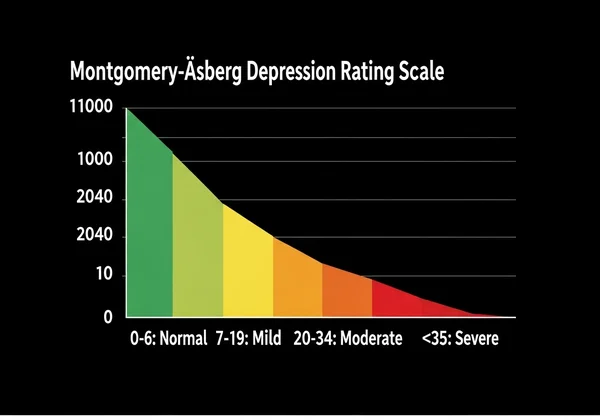Montgomery-Åsberg Depression Rating Scale (MADRS) Questions & Scoring: A Comprehensive Guide
The Montgomery-Åsberg Depression Rating Scale (MADRS) is a critical tool for accurately assessing and monitoring depressive symptoms. Whether you are a medical professional, a student, or an individual wanting to understand your own mental health, a clear grasp of this tool is invaluable. What are the 10 questions on the MADRS? This in-depth guide explains each of the 10 MADRS questions and their scoring nuances, helping you interpret results confidently. For a practical application of this knowledge, you can take the free MADRS assessment at any time.

Deciphering Each of the 10 MADRS Scale Questions
The MADRS is a sophisticated, clinician-rated scale designed to measure the severity of depressive episodes. It consists of 10 items that evaluate core symptoms, from emotional states to physical sensations. Each item is carefully chosen to provide a comprehensive picture of an individual's condition. Let's explore each one in detail.
Item 1: Apparent Sadness & Its Observational Cues
Sadness that is observable to the clinician or assessor is evaluated by this first item. It's not about what the person says, but what their body language and expressions convey. This includes despondency, gloom, and despair. An assessor looks for observational cues such as a downturned mouth, tearfulness, or a slumped posture, which can indicate the depth of sadness even when the person finds it hard to articulate their feelings.
Item 2: Reported Sadness and Subjective Experience
In contrast to the first item, this question focuses on the individual's own report of their feelings. It captures the internal subjective experience of sadness, low spirits, or hopelessness. The scoring reflects the intensity, duration, and pervasiveness of these feelings. It acknowledges that what a person feels inside is a crucial component of their depressive state, independent of how much they show it on the outside.
Item 3: Inner Tension and Recognizing Psychological Unease
Depression isn't just sadness; it often involves a distressing sense of inner turmoil. This item assesses feelings of ill-defined distress, edginess, and mental torment. The score is based on the intensity of this psychological unease, from a mild sense of restlessness to an overwhelming feeling of anguish. It indicates the psychological pain often associated with depression. For those looking to quantify this, a MADRS Test can provide a structured starting point.
Item 4: Reduced Sleep: Patterns and Severity
Sleep disturbance is a hallmark symptom of depression. This item evaluates reductions in the duration or depth of sleep compared to the individual's normal pattern. The scoring considers both the difficulty falling asleep and the experience of waking during the night or early in the morning. Understanding the specific patterns and severity of sleep disruption is vital for a complete clinical picture.
Item 5: Reduced Appetite: Beyond Just Eating Habits
Similar to sleep, appetite is often significantly affected by depression. Any decrease in appetite and the need to force oneself to eat is assessed by this item. It looks beyond just eating habits to the underlying loss of interest in food or pleasure from eating. In severe cases, it can manifest as significant weight loss, highlighting a critical physical consequence of the mental state.
Item 6: Concentration Difficulties & Cognitive Impairment
Depression can make it incredibly difficult to think clearly. This item measures difficulties with focus, memory, and decision-making. The severity ranges from occasional forgetfulness to a near-complete inability to concentrate on tasks that were once simple, such as reading a book or following a conversation. This cognitive impairment is often referred to as "brain fog" and can be one of the most frustrating aspects of depression.

Item 7: Lassitude: Fatigue and Energy Levels
Lassitude refers to a profound sense of weariness and low energy that isn't relieved by rest. This item evaluates difficulty getting started in the morning and a feeling of being slowed down in thoughts and actions. The focus is on fatigue and energy levels that interfere with daily functioning, making even small tasks feel monumental. A MADRS self-report can help track these energy fluctuations over time.
Item 8: Inability to Feel: Understanding Anhedonia
This item addresses one of the most painful symptoms of severe depression: anhedonia, or the inability to experience pleasure. It assesses a reduction or loss of interest in activities that were once enjoyable, as well as a diminished capacity to feel emotions in general. Understanding anhedonia is crucial, as it represents a profound disconnection from life and can be a strong indicator of the severity of the depression.
Item 9: Pessimistic Thoughts & Negative Cognition
Depression fundamentally alters a person's thought patterns. The presence of pessimistic or nihilistic thoughts, including feelings of guilt, self-reproach, and hopelessness about the future, is assessed by this item. The scoring reflects the pervasiveness of this negative cognition, from fleeting doubts to deeply held delusions of ruin and remorse. These thoughts can create a powerful, self-perpetuating cycle of depression.
Item 10: Suicidal Thoughts and Risk Assessment
This final, critical item evaluates the presence and intensity of suicidal ideation. It ranges from feeling that life is not worth living to making explicit plans for suicide. A thorough risk assessment is paramount, and any indication of suicidal thoughts requires immediate attention and professional intervention. This item underscores the seriousness of depression and the importance of seeking help.
Comprehensive MADRS Scoring & Interpretation
Once all 10 questions are answered, the scores are tallied to provide a quantitative measure of depression severity. This is a key part of the MADRS scoring process. Understanding how this works is central to using the tool effectively.
The 0-6 Point Scale: Defining Severity for Each Item
Each of the 10 MADRS items is rated on a 7-point scale, from 0 to 6. A score of 0 indicates the absence of a particular symptom, while a score of 6 represents the most severe presentation of that symptom. This granular scale allows for defining severity with a high degree of nuance, capturing subtle changes in a person's condition over time. Its detailed evaluation makes the MADRS a powerful clinical tool.
Calculating Your Total MADRS Score
The total MADRS score is simply the sum of the scores from all 10 items. The process is straightforward: rate each of the 10 questions on the 0-6 scale and add them together. This will result in a total score that can range from 0 to 60. You can get an instant calculation by completing a MADRS online test, which removes any chance of manual error and provides immediate results.
Interpreting MADRS Score Ranges: What Your Score Means
The total score corresponds to a specific level of depression severity, providing a clear framework for MADRS score interpretation. While specific clinical thresholds can vary slightly, a widely accepted guide is as follows:
-
0-6: Normal / No depression
-
7-19: Mild depression
-
20-34: Moderate depression
-
≥35: Severe depression

These ranges help clinicians and individuals understand the current state, monitor treatment progress, and make informed decisions about care.
Mastering MADRS for Deeper Insights & Informed Decisions
Understanding the individual MADRS questions and the scoring system empowers you to use this tool to its full potential. The score, when understood in context, reveals a detailed picture of a person's depressive experience. This knowledge is key for accurate assessment, effective treatment monitoring, and compassionate support.
If you are ready to gain a clearer picture of your own mental health or that of someone you care for, the next step is to use a reliable assessment tool. We invite you to discover your results by taking our free, confidential MADRS assessment. Our platform provides not only an instant score but also the option to unlock a unique, AI-driven report for personalized insights and actionable steps.
Your Top Questions About MADRS Explained
What are the 10 questions on the MADRS?
The 10 questions cover key areas of depression: Apparent Sadness, Reported Sadness, Inner Tension, Reduced Sleep, Reduced Appetite, Concentration Difficulties, Lassitude (fatigue), Inability to Feel (anhedonia), Pessimistic Thoughts, and Suicidal Thoughts. Each provides a unique window into the experience of depression.
How do you interpret MADRS scores?
MADRS scores are interpreted in ranges: 0-6 suggests no depression, 7-19 indicates mild depression, 20-34 points to moderate depression, and a score of 35 or more signifies severe depression. This helps gauge the severity and track changes over time. You can get a quick and confidential score on our clinically trusted tool.
Is the MADRS test free?
Yes, taking the standard 10-question MADRS assessment on our platform and receiving your score is completely free. We also offer an optional, in-depth AI-powered analysis for users who want to gain deeper, personalized insights into their results for a small fee.
Can I use MADRS for self-assessment?
While the MADRS was originally designed as a clinician-rated scale, it is widely used for self-assessment to monitor symptoms. A MADRS self-report can be a valuable tool for tracking your mental health journey. However, it is crucial to remember that it is an informational tool and not a substitute for a professional diagnosis. Always discuss your results with a doctor or mental health professional.